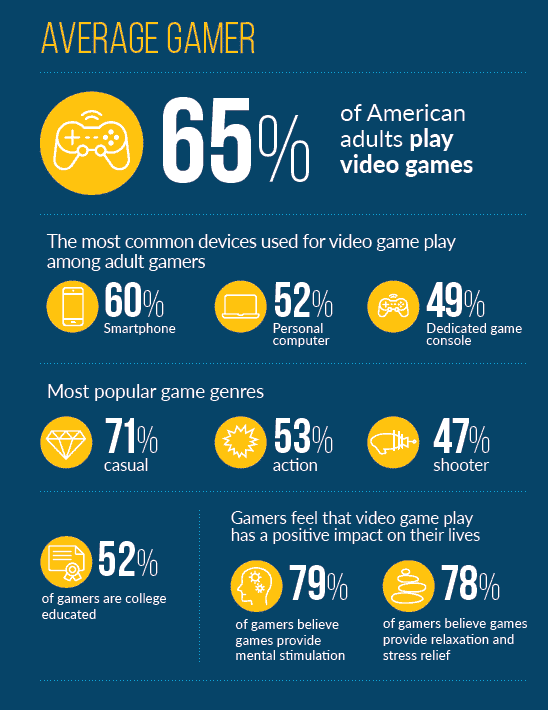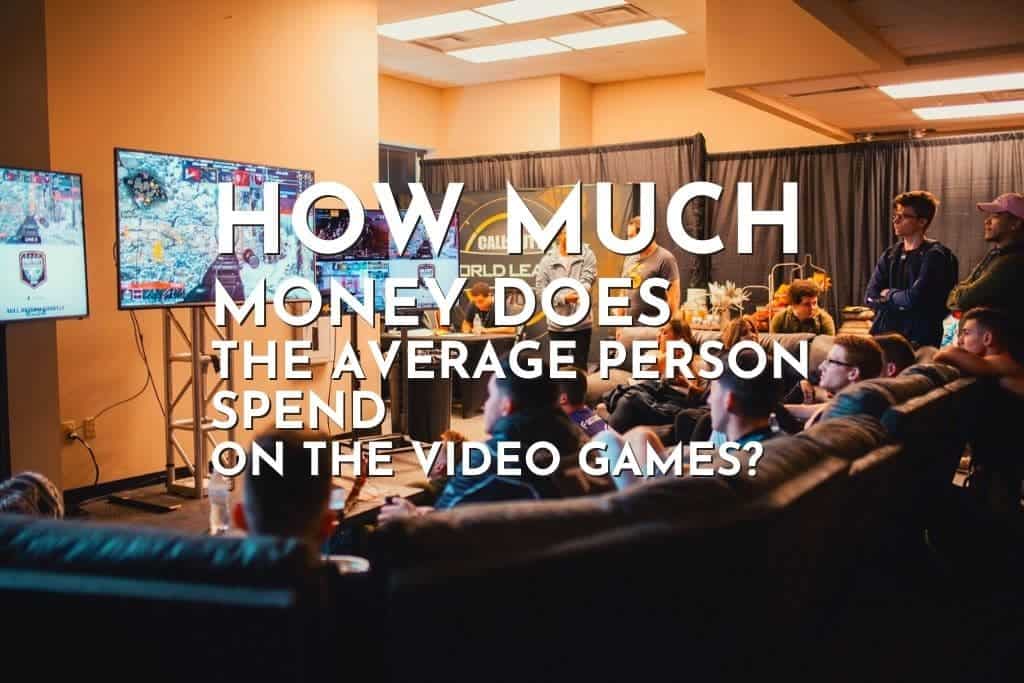The annual Electronic Entertainment Expo (E3) for a gamer is probably the most exciting expo of the year. You get to see new game releases and companies share information on future projects, new hardware, etc.
Everyone is getting their wallets ready in anticipation of these new game titles. Some people on PC might have to upgrade their hardware in order to enjoy the upcoming AAA titles.
Lord Gaben is coming for your money, and you will inevitably end up buying 50 indie games for 10 dollars that you’ll never play because there is a backlog of 100 games lying around in your Steam library.
So how much does the average person spend on video games? This is a rough estimate; based on figures provided by the ESA and Statista, we believe the average American gamer spent 216.64 dollars on games in 2018. We can assume the global average by dividing total video game market revenue for 2018 with the total number of gamers, which is $137.9 billion divided by 2.3 billion giving us $55.16 spent on video games by the average gamer worldwide for 2018.
How did we arrive at these numbers? While the answer depends on what platform you use, which country you’re from, the types of games you play, and your income, Statista shows that Americans spent $43.3 billion on video games in 2018. That includes $35.8 billion on software (games, microtransactions, etc.), $5.1 billion on hardware (consoles and PC components), and $2.4 billion on accessories (controllers, headsets, etc.).
According to a 2018 market study made by Statista, there are 199.87 million gamers in America. If we take the total amount of money spent on video games and divide it by the number of gamers, we get the amount of money spent by the average American gamer per year. Which is 216.64 dollars (43.3 billion/ 199.87 million).
This doesn’t tell us anything about gamers from other parts of the world, unfortunately. How much does the average gamer in China spend per year? What about countries with lower per capita income and low internet penetration rates, such as Indonesia, India, Brazil, etc.?
Also, when we took our average spending statistics for 2018, we considered all of the 2.3 billion active gamers worldwide. In reality, just 46% of these 2.3 billion gamers spend money on video games. Which would mean the gaming revenue of 137.9 billion dollars generated in 2018 was from 1.058 billion “paying” gamers.
You also have to consider the fact that free-to-play games such as Fortnite are making way more money than premium AAA games. Fortnite made 2.4 billion dollars in revenue just for 2018, setting a record for the highest yearly revenue of any game in history.
It made 300 million dollars in April 2018 alone. The student loan portal lendedu.com did a survey of 1000 Fortnite players in June 2018 and asked them about their spending habits within the game. About 69% of the players confirmed spending money in-game on cosmetics such as skins, emotes, etc.
The average amount of money spent per person within the survey sample was $84.67. An April 2018 report by analytics firm Sensor Tower claims Fortnite was making $1 million per day on average back then. That’s a lot of money from a “free” game.
There is no definitive answer to the question “how much does the average person spend on video games” since it can vary based on a dozen different factors. But in this article, we shall provide you with a more in-depth view of the spending habits of gamers from various regions.
Who Is Playing Video Games?

According to the “2019 Essential Facts about the Computer and Video Game Industry” report released by ESA, 65% percent of American adults play video games. And the average gamer isn’t some nerdy teenager locked up in his mom’s basement; rather, the average gamer is 33 years old.
Surprising, right? This report also states that 75% of Americans have at least one gamer in the house, and the gender split right now is 54% male vs. 46% female. Most female “gamers” are above 30 years of age and play casual games such as Candy Crush on their mobile phones.
Sixty percent of American gamers play on mobile devices, 52 percent play on PC, and 49 percent own a game console such as Xbox or PlayStation. The average age for a female gamer is 34, while the average age for male gamers is 32.
Casual games are the most popular, followed by action and shooter games. The core gamer base plays on console and PC, and they engage with more hardcore games such as Call of Duty, Rainbow Six, League of Legends, World of Warcraft, etc., while the majority of casual gamers are on phones.
One thing to note is that gamers tend to spend money based on their income, directly related to age. Obviously, it is less likely that you will spend a thousand bucks on microtransactions per year if you are under 18 and live with your parents. On the other hand, gamers over the age of 30 tend to have a lot more freedom when it comes to spending money on hardware or in-game content.
Looking at the age demographics across platforms, PC has the highest average age for game purchasers at 38 years, followed by smartphones and consoles at 37 and 33 years, respectively.
Compared to the average mobile or console gamer, the average PC gamer is likely to spend more money on cosmetics, characters, weapon skins, etc. But mobile gaming revenue is higher than PC gaming revenue because of the sheer volume of mobile gamers who match PC and console combined.
This report also claims that 49% of gamers have made a microtransaction in the past year, while 29% pay for subscription services such as Xbox Live, Game Pass, EA Origin Access, etc.
Different age groups have different game choices, and this, combined with their income, affects how much money they spend on video games per year. A 35-year-old playing FIFA will spend more money on gaming per year compared to a 15-year-old playing Resident Evil 2.
Firstly, the 35-year-old probably has a job and hence a larger budget to spend on hobbies. Secondly, Resident Evil 2 is a single-player game with a relatively low degree of in-game monetization, compared to FIFA, a microtransaction galore, with EA earning $790 million in 2018 alone.
The top-selling game of 2018 in terms of units sold is Call of Duty: Black Ops 4, followed by Red Dead Redemption II and NBA 2K19. These games are from three different genres- FPS, action-adventure, and sports.
According to the report by ESA, male millennial gamers between the age of 18- 34 prefer action, shooter, and sports games such as Fortnite, Madden, God of War, etc. Female gamers in the same age group prefer casual games such as Candy Crush.
Male Gen X gamers aged 35 to 54 also like sports and shooter games, in addition to racing games (a lot of males in this age group also own cars in real life). So it is safe to assume that males in the age group of 18 to 54 were the biggest spenders in last year’s top-grossing games, all shooters, action, and sports games.

Thus, the average U.S. gamer is between 18 to 54 (likely male), plays on a console or PC, and spends money mostly on action or shooter games.
Based on the most recent statistics, gamers older than 18 years represent nearly 70 percent of the video game-playing population. Annual spending on video game content in the U.S. has been on an upward trend since 2010, and the amount of money people spend on hardware and accessories is also on the rise.
With increasing PC component prices each year, we can speculate that it will cost you more to be a PC gamer over the next few years as a graphics card and CPU prices keep climbing upwards.
How Much Do We Spend On Mobile Games?

According to a Gaming Trend Report for 2019 by the global web index, 66 percent of gamers worldwide have used their smartphones for playing games.
The emergence of casual and hyper-casual games has significantly increased the number of people playing on smartphones or tablets. It has opened up new revenue streams for mobile game developers over the past few years.
Older gamers who play puzzle, board, card, and platformer games prefer mobile since it is convenient to use and carry around, plus the games are relatively simple to pick up compared to PC or console.
It is predicted that in 2019, mobile games will generate $68.5 billion worldwide. This assumes a 10.2% on the Year growth rate, which is totally possible if you monitor the rate at which mobile gaming has been growing for the past decade.
The total number of active gamers in the world is estimated to be around 2.5 billion right now. Depending on which source you use, the percentage of people who play on mobile can vary. If we go by global web index stats, which say 66 percent of gamers worldwide play on mobile devices, that would mean we have nearly 1.65 billion mobile gamers worldwide, generating 68.5 billion dollars in 2019.
This translates to $41.51 spent in 2019 by the average mobile gamer. Of course, these are just predictions, and until 2020, we cannot get the exact numbers for how much money mobile gaming will generate this year.
But if anything, it is more likely to be higher than the predicted value instead of lower. The majority of mobile gaming revenue will be generated from the APAC region, which contains 1.234 billion gamers by itself.
How Much Do We Spend On Gaming Hardware

If we’re going to consider how much money the average gamer spends on video games per year, we might as well take into consideration hardware purchases.
You can’t play without a console or PC, and that 5-year-old smartphone won’t do an excellent job of running the newest mobile releases. You will also need controllers for your console, upgrades for your PC, and other accessories such as headsets, batteries for controllers, hard drives, etc.
In 2017, Americans spent $36 billion on video games. Out of this, $6.9 billion was spent on hardware. The average game console costs between 399 to 499 if you purchase it brand- new. Add in a 60 dollar yearly subscription for playing online, along with a hundred dollars in batteries over the year.
You could be spending anywhere from 560 to 660 dollars just on hardware, at least for the first year in which you purchase the console. Most console gamers purchase a new console every 3 to 5 years. On PC, the story is different.
If you spend a grand and build a beefy rig, it will likely last you 4 to 5 years before you absolutely need an upgrade. The nice thing about the PC platform is the fact that it is modular. So instead of replacing the whole thing as you would with a console, you simply swap out one or two components like the GPU or CPU, and you’re good for another 3 or 4 years.
You also don’t need to spend 60 dollars per year to play online on PC. Each year fewer gamers are spending on physical copies of games, choosing to buy digital downloads instead.
If we look at the console side of things, Sony is winning the war by a large margin. It shifted 18 million PlayStation 4s just in 2018, bringing the total number of PS4s sold since release up to a staggering 91.6 million.
In comparison, the Nintendo Switch sold 17.05 million units and the Xbox One a relatively low 6.96 million units for 2018. Hardware sales are much harder to track for PC since there are a dozen different components, and tracking the sales of each one is pretty hard.
But if we look at the graphics card market for the first quarter of 2018, based on a JPR report, over 5 billion dollars worth of AIB or aftermarket graphics cards were shipped in Q1 2018. A large portion of this can be attributed to the mining craze in early to mid-2018, when Bitcoin values skyrocketed.
To know which graphics cards are the most popular among average PC gamers, we can look at the Steam hardware survey. Keep in mind that prices for PC components tend to fluctuate, unlike consoles which cost the same everywhere at all times of the year. The most popular GPU is the NVIDIA GTX 1060, which was released as a 250 dollar model for the midrange.
Conclusion
The gaming industry keeps growing each year, reaching record heights in terms of revenue and player counts. While game prices have stayed the same since forever, the cost of manufacturing a game has gone up, especially if we look at triple-A titles such as God of War, Grand Theft Auto (GTA V cost a whopping 256 million to develop), etc.
As a result, game developers are finding new and creative ways to maximize their profits, trying to squeeze every bit of money they can from the players. This happens in the form of gameplay altering microtransactions where you pay more for in-game benefits such as better weapons and armor.
Or, it can be cosmetic skins that offer no performance benefits but make your character look cooler and stand out from the rest of the plebs who can’t afford to pay for shiny hats.
If you’re on PC, the future is looking more expensive than ever as hardware prices continue to rise, especially in the GPU market, where NVIDIA is basically running a monopoly.
Will game subscription services like EA Origin Access and Microsoft Game Pass for PC help you play your favorite titles for cheaper? Maybe in the short term, they are cheaper than buying 60 dollar copies of games, but you must remember that subscriptions have their flaws- you don’t really own the games, and at any point, you can be de-platformed for violating guidelines.
Game streaming services might bring down the cost of gaming for the average gamer who doesn’t care too much about visual fidelity or framerate and just wants to play games.

